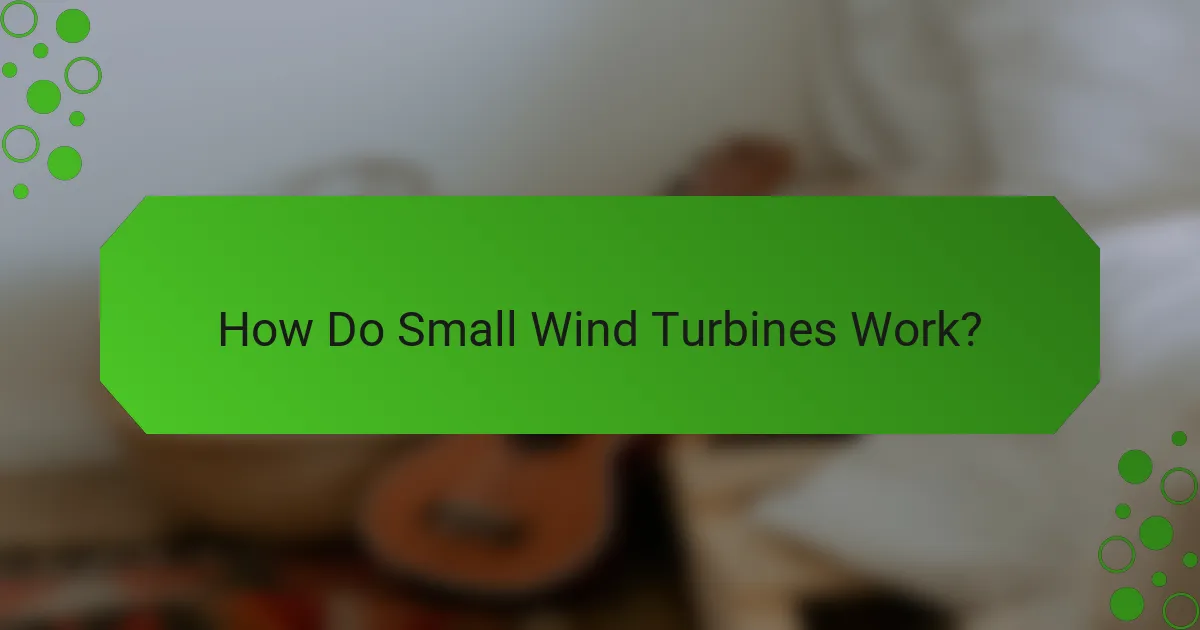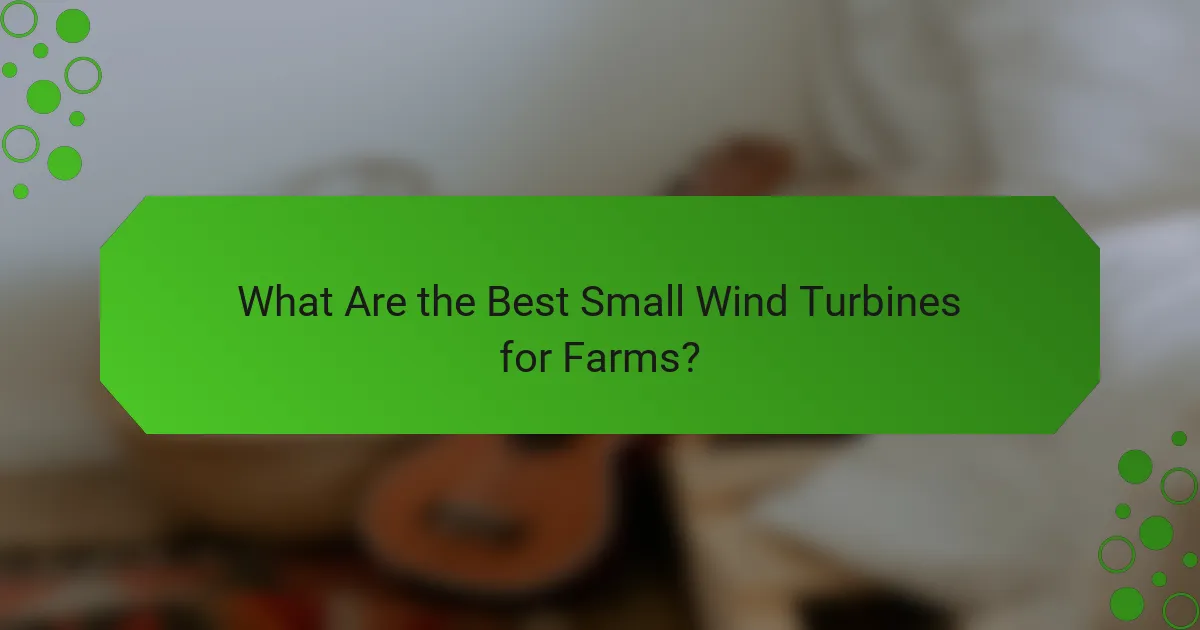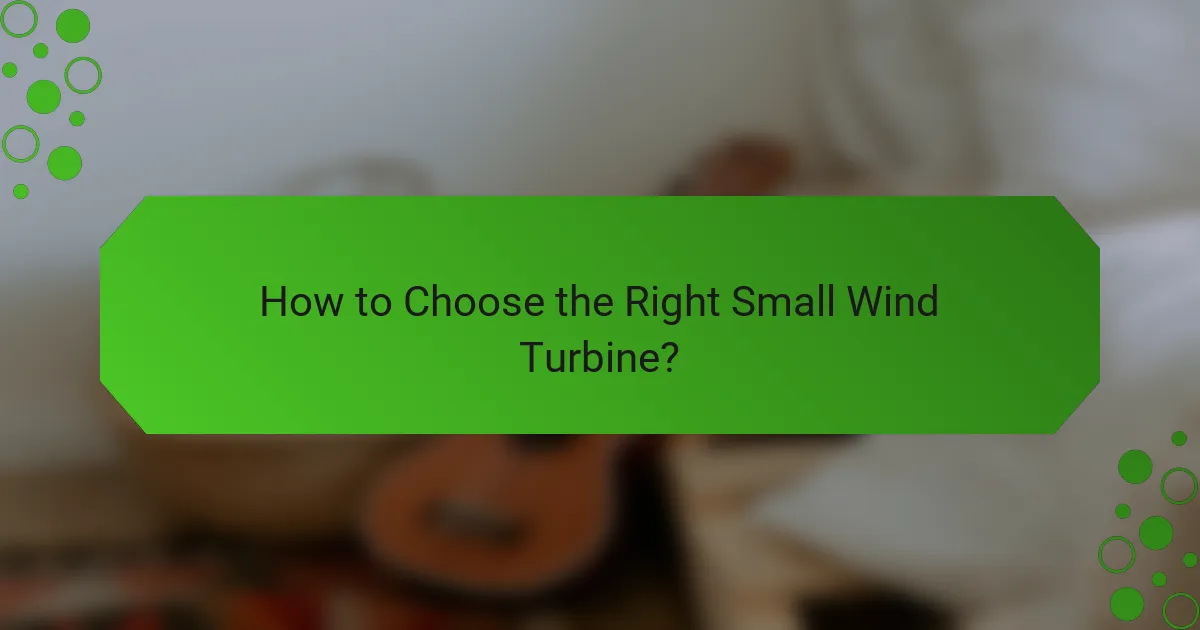Small wind turbines are an increasingly popular solution for farms seeking to enhance sustainability and reduce energy costs. By converting wind energy into electricity, these systems offer benefits such as energy independence and lower operational expenses. However, potential buyers should carefully evaluate the costs associated with purchase, installation, and maintenance to make informed decisions.

What Are the Costs of Small Wind Turbines?
The costs of small wind turbines can vary significantly based on factors such as size, location, and installation specifics. Generally, potential buyers should consider initial purchase prices, installation expenses, maintenance costs, operational costs, and available financing options.
Initial purchase price
The initial purchase price of small wind turbines typically ranges from a few thousand to tens of thousands of dollars, depending on the turbine’s capacity and brand. For example, a small turbine suitable for residential use may cost between $10,000 and $50,000. It’s essential to evaluate the turbine’s efficiency and expected energy output to ensure a good investment.
Installation expenses
Installation expenses can add significantly to the overall cost, often ranging from 20% to 50% of the turbine’s purchase price. Factors influencing installation costs include site preparation, tower height, and local regulations. Engaging with experienced installers can help avoid common pitfalls and ensure compliance with local codes.
Maintenance costs
Maintenance costs for small wind turbines are generally low but should still be factored into the overall budget. Annual maintenance might range from a few hundred to a couple of thousand dollars, depending on the turbine’s size and usage. Regular inspections and timely repairs can extend the lifespan of the turbine and improve efficiency.
Operational costs
Operational costs primarily include insurance, property taxes, and any necessary permits. These costs can vary widely based on location and local regulations. It’s advisable to consult with local authorities to understand the specific operational costs associated with small wind turbines in your area.
Financing options
Financing options for small wind turbines include personal loans, government grants, and incentives. Many regions offer tax credits or rebates to encourage renewable energy investments, which can significantly reduce upfront costs. Researching local and federal programs can help identify the best financing strategies for your project.

What Benefits Do Small Wind Turbines Offer?
Small wind turbines provide several advantages, including energy independence, cost savings on electricity, and a positive environmental impact. These benefits make them an appealing option for farms looking to enhance sustainability and reduce operational costs.
Energy independence
Small wind turbines enable farms to generate their own electricity, reducing reliance on the grid. This energy independence can be particularly valuable in remote areas where electricity supply may be unreliable or costly.
By harnessing wind energy, farms can create a stable energy source, which can help mitigate the effects of fluctuating energy prices. This self-sufficiency enhances resilience against energy shortages and price hikes.
Reduced electricity bills
Investing in small wind turbines can lead to significant reductions in electricity bills. By generating their own power, farms can offset a large portion of their energy costs, often resulting in savings of 30% to 50% on monthly utility bills.
Additionally, any excess energy produced can often be sold back to the grid, providing an additional revenue stream. This can further enhance the financial viability of the investment in wind technology.
Environmental impact
Small wind turbines contribute to a lower carbon footprint by utilizing renewable energy. They produce clean electricity without the greenhouse gas emissions associated with fossil fuels, making them an eco-friendly choice for farms.
Moreover, the use of wind energy helps to conserve water resources, as wind power generation does not require water for cooling or processing, unlike traditional power plants. This aspect is particularly beneficial in agricultural settings where water conservation is crucial.
Government incentives
Many governments offer incentives for the installation of small wind turbines, which can significantly lower the initial investment cost. These incentives may include tax credits, grants, or rebates, making wind energy more accessible for farmers.
In the United States, for example, the federal investment tax credit allows for a substantial deduction on the cost of wind turbine installations. It is advisable for farmers to research local and federal programs to maximize financial benefits when considering wind energy solutions.

How Do Small Wind Turbines Work?
Small wind turbines convert wind energy into electrical energy through a series of mechanical processes. They are designed to harness wind power efficiently, making them suitable for residential, agricultural, and small commercial applications.
Basic operating principles
Small wind turbines operate on the principle of aerodynamic lift, where the wind flows over the blades, creating a difference in pressure that causes them to spin. This rotational motion is then converted into electrical energy through a generator. The efficiency of this process depends on factors such as wind speed, turbine design, and blade angle.
Typically, small wind turbines are most effective in areas with average wind speeds of at least 4 to 5 meters per second. Proper site assessment is crucial to ensure optimal performance and energy production.
Components of small wind turbines
A small wind turbine consists of several key components: the rotor, blades, generator, tower, and control system. The rotor and blades capture wind energy, while the generator converts the mechanical energy into electricity. The tower elevates the turbine to capture stronger winds, and the control system manages the turbine’s operations and safety.
Commonly, small wind turbines range from 400 watts to 10 kilowatts in capacity. Choosing the right size depends on energy needs, local wind conditions, and installation space.
Energy conversion process
The energy conversion process in small wind turbines begins when the wind turns the blades, which are connected to the rotor. As the rotor spins, it drives the generator, producing electricity. This electricity can be used immediately, stored in batteries, or fed into the grid, depending on the system setup.
Efficiency in this conversion can be affected by various factors, including wind turbulence and turbine maintenance. Regular inspections and upkeep are essential to maximize energy output and prolong the turbine’s lifespan.

What Are the Best Small Wind Turbines for Farms?
The best small wind turbines for farms depend on factors such as energy needs, budget, and site conditions. Popular models from leading brands offer various features tailored to agricultural applications, making them suitable for different farming environments.
Brand A models
Brand A offers several models designed specifically for agricultural use, focusing on efficiency and durability. Their turbines typically range from 5 kW to 15 kW, making them ideal for small to medium-sized farms.
One notable model is the A-10, which features a robust design and can generate sufficient power for farm operations. It is essential to consider installation costs and local zoning regulations when selecting a model from Brand A.
Brand B models
Brand B specializes in compact wind turbines that are particularly suited for rural areas. Their models, such as the B-5, are known for their low noise levels and ease of maintenance, making them a popular choice among farmers.
These turbines generally produce between 2 kW and 10 kW, providing a reliable energy source for smaller farms or specific applications like irrigation systems. Farmers should evaluate the wind resource at their location to ensure optimal performance.
Brand C models
Brand C’s offerings include innovative designs that maximize energy capture in varying wind conditions. Their turbines, like the C-12, are capable of generating between 8 kW and 20 kW, making them suitable for larger agricultural operations.
When considering Brand C, farmers should assess the upfront investment against potential long-term savings on energy bills. Additionally, it’s advisable to check for any available incentives or rebates that can offset installation costs.

How to Choose the Right Small Wind Turbine?
Choosing the right small wind turbine involves evaluating site conditions, power needs, and regulatory requirements. A thorough assessment of these factors ensures optimal performance and cost-effectiveness.
Site assessment criteria
Site assessment is crucial for determining the feasibility of a small wind turbine installation. Key criteria include wind speed, terrain, and proximity to obstacles such as trees or buildings. Ideally, locations with average wind speeds of at least 4-5 m/s are preferred.
Conducting a wind resource assessment over a year can provide valuable data. Tools like anemometers can help measure wind patterns and identify the best spots for turbine placement.
Power output requirements
Understanding power output requirements is essential for selecting a suitable turbine. Calculate your energy needs by reviewing past electricity bills and determining the average monthly consumption in kilowatt-hours (kWh).
Small wind turbines typically range from 1 kW to 10 kW in capacity. For example, a household with a monthly usage of 800 kWh may benefit from a 5 kW turbine, which can generate enough energy to offset a significant portion of their consumption.
Regulatory considerations
Before installing a small wind turbine, familiarize yourself with local regulations and zoning laws. Many areas require permits for installation, and regulations can vary widely by region.
Check with local authorities about any restrictions on height, noise levels, and visual impact. In some cases, incentives or rebates may be available to offset installation costs, so it’s wise to explore these options as well.

What Are the Common Applications of Small Wind Turbines on Farms?
Small wind turbines are commonly used on farms for various applications, primarily to generate electricity for on-site use. They can help reduce energy costs, power irrigation systems, and support other farm operations.
Electricity Generation
Small wind turbines can effectively generate electricity for farm operations, reducing reliance on grid power. These turbines typically range from 1 kW to 10 kW in capacity, making them suitable for powering equipment, lighting, and heating systems.
Farmers can save on energy costs by using wind-generated electricity, which can be particularly beneficial in rural areas where electricity prices may be higher. Additionally, excess energy can often be sold back to the grid, providing an additional revenue stream.
Irrigation Support
Wind turbines can power irrigation systems, ensuring consistent water supply for crops. By using renewable energy, farmers can lower their operational costs while maintaining efficient irrigation practices.
In regions with variable energy prices, wind-powered irrigation can be a cost-effective solution. Farmers should assess their water needs and the turbine’s output to determine the best system size for their specific requirements.
Heating and Cooling Systems
Small wind turbines can also contribute to heating and cooling systems on farms, such as greenhouses or livestock facilities. By providing a renewable energy source, these turbines can help maintain optimal temperatures for crops and animals.
Farmers should consider integrating wind energy with existing heating and cooling systems to maximize efficiency. Evaluating energy consumption patterns can help determine the appropriate turbine size for these applications.
Remote Monitoring and Automation
Wind turbines can support remote monitoring and automation systems on farms, enhancing operational efficiency. By generating their own electricity, farmers can power sensors and automated systems that monitor soil moisture, weather conditions, and crop health.
Investing in small wind turbines can facilitate data-driven decision-making, leading to improved crop yields and resource management. Farmers should explore compatible technologies to fully leverage the benefits of wind energy.
